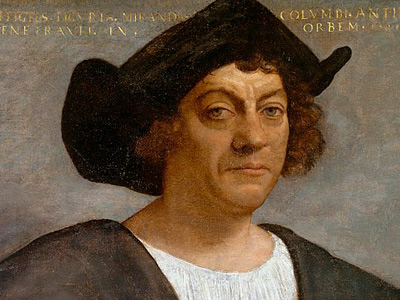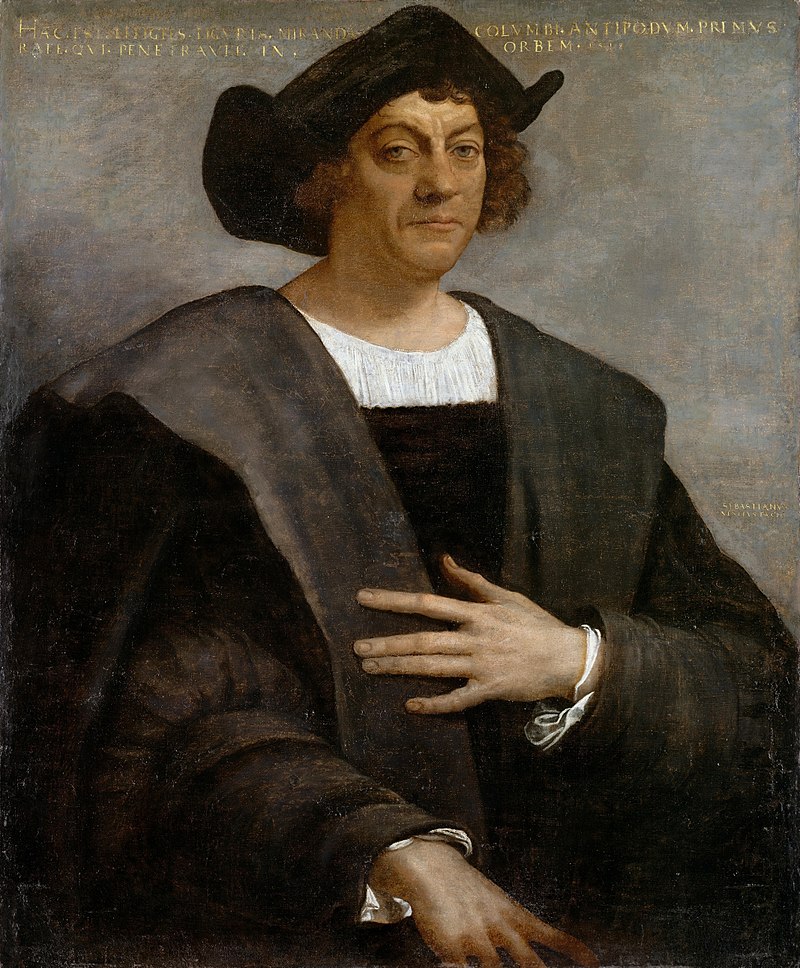Christopher Columbus (1451-1506)
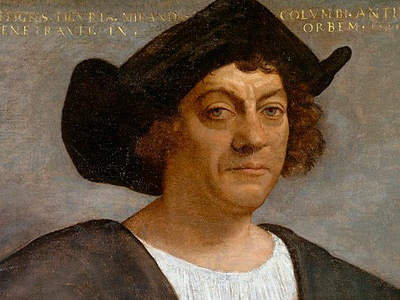
First Voyage
On the evening of 3 August 1492, Columbus departed from Palos de la Frontera with three ships: a larger carrack, the Santa María ex-Gallega ("Galician"), and two smaller caravels, the Pinta ("The Pint", "The Look", or "The Spotted One") and the Santa Clara, nicknamed the Niña ("Girl") after her owner Juan Niño of Moguer. The monarchs forced the citizens of Palos to contribute to the expedition. The Santa María was owned by Juan de la Cosa and captained by Columbus. The Pinta and the Niña were piloted by the Pinzón brothers (Martín Alonso and Vicente Yáñez).
Columbus first sailed to the Canary Islands, which belonged to Castile. He restocked provisions and made repairs in Gran Canaria, then departed from San Sebastián de La Gomera on 6 September, for what turned out to be a five-week voyage across the ocean. At about 2:00 in the morning of 12 October, a lookout on the Pinta, Rodrigo de Triana (also known as Juan Rodríguez Bermeo), spotted land, and immediately alerted the rest of the crew with a shout. Thereupon, the captain of the Pinta, Martín Alonso Pinzón, verified the discovery and alerted Columbus by firing a lombard. Columbus later maintained that he himself had already seen a light on the land a few hours earlier, thereby claiming for himself the lifetime pension promised by Ferdinand and Isabella to the first person to sight land.
Columbus called the island (in what is now The Bahamas) San Salvador; the natives called it Guanahani. Exactly which island in the Bahamas this corresponds to is unresolved. Based on primary accounts and on what one would expect from the geographic positions of the islands given Columbus's course, the prime candidates are San Salvador Island (so named in 1925 on the theory that it was Columbus's San Salvador), Samana Cay, and Plana Cays.
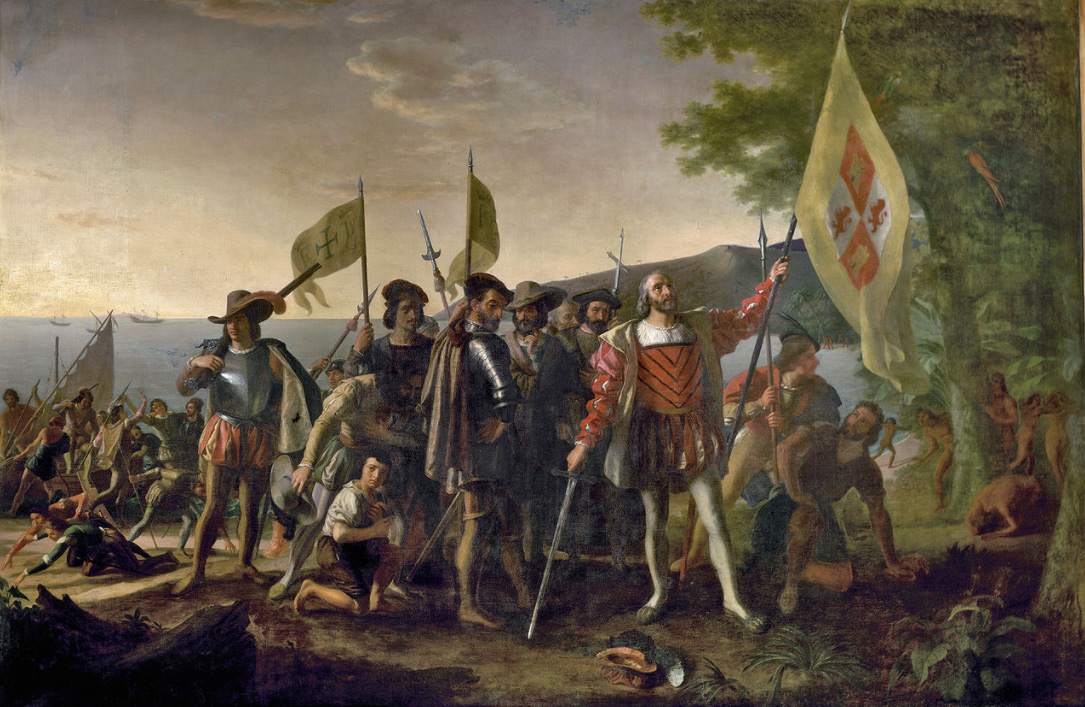
Landing of Columbus (12 October 1492), painting by John Vanderlyn
The indigenous people he encountered, the Lucayan, Taíno, or Arawak, were peaceful and friendly. Noting their gold ear ornaments, Columbus took some of the Arawaks prisoner and insisted that they guide him to the source of the gold. From the entry in his journal of 12 October 1492, in which he wrote of them: "Many of the men I have seen have scars on their bodies, and when I made signs to them to find out how this happened, they indicated that people from other nearby islands come to San Salvador to capture them; they defend themselves the best they can. I believe that people from the mainland come here to take them as slaves. They ought to make good and skilled servants, for they repeat very quickly whatever we say to them. I think they can very easily be made Christians, for they seem to have no religion. If it pleases our Lord, I will take six of them to Your Highnesses when I depart, in order that they may learn our language." Columbus remarked that their lack of modern weaponry and metal-forged swords or pikes was a tactical vulnerability, writing, "I could conquer the whole of them with 50 men, and govern them as I pleased."
Columbus also explored the northeast coast of Cuba, where he landed on 28 October. On 22 November, Martín Alonso Pinzón took the Pinta on an unauthorized expedition in search of an island called "Babeque" or "Baneque", which the natives had told him was rich in gold. Columbus, for his part, continued to the northern coast of Hispaniola, where he landed on 5 December. There, the Santa María ran aground on Christmas Day 1492 and had to be abandoned. The wreck was used as a target for cannon fire to impress the native peoples. Columbus was received by the native cacique Guacanagari, who gave him permission to leave some of his men behind. Columbus left 39 men, including Luis de Torres, the Converso interpreter, who spoke Hebrew and Arabic, and founded the settlement of La Navidad at the site of present-day Bord de Mer de Limonade, Haiti. Columbus took more natives prisoner and continued his exploration. He kept sailing along the northern coast of Hispaniola with a single ship, until he encountered Pinzón and the Pinta on 6 January.
On 13 January 1493, Columbus made his last stop of this voyage in the New World, in the Bay of Rincón at the eastern end of the Samaná Peninsula in northeast Hispaniola. There he encountered the warlike Cigüayos, the only natives who offered violent resistance during his first voyage to the Americas. The Cigüayos refused to trade the amount of bows and arrows that Columbus desired; in the ensuing clash one Ciguayo was stabbed in the buttocks and another wounded with an arrow in his chest. Because of this and because of the Cigüayos' use of arrows, he called the inlet where he met them the Bay of Arrows (or Gulf of Arrows). Columbus kidnapped about 10 to 25 natives and took them back with him (only seven or eight of the natives arrived in Spain alive).
Columbus headed for Spain on the Niña, but a storm separated him from the Pinta, and forced the Niña to stop at the island of Santa Maria in the Azores. Half of his crew went ashore to say prayers in a chapel to give thanks for having survived the storm. But while praying, they were imprisoned by the governor of the island, ostensibly on suspicion of being pirates. After a two-day standoff, the prisoners were released, and Columbus again set sail for Spain.
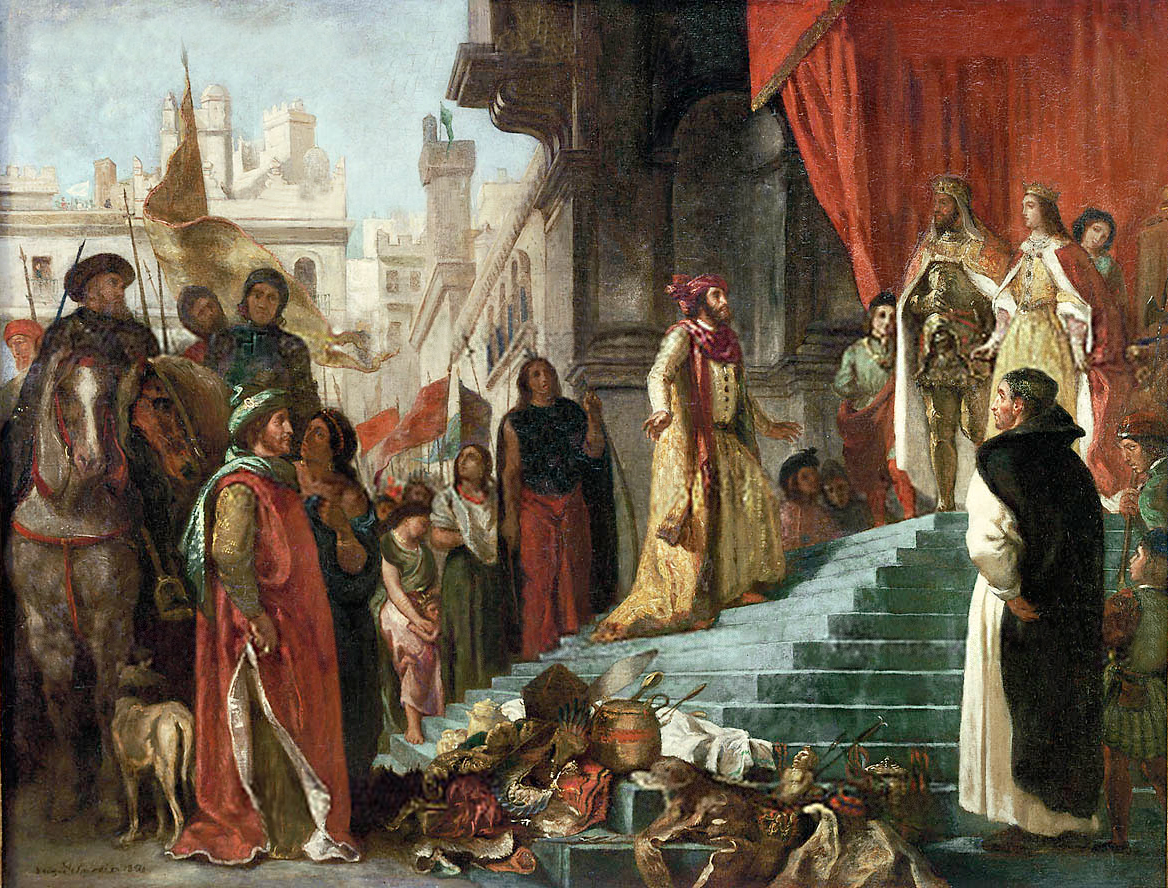
The return of Christopher Columbus; his audience before King Ferdinand and Queen Isabella, painting by Eugène Delacroix
Another storm forced him into the port at Lisbon. He anchored next to the King's harbor patrol ship on 4 March 1493 in Portugal. There, he was interviewed by Bartolomeu Dias, who had rounded the Cape of Good Hope a few years earlier, in 1488–1489. Dias's success had complicated Columbus's attempts to secure funding from the Portuguese court because the sure route to the Indies that Dias pioneered made a risky, conjectural western route unnecessary. Not finding King John II of Portugal in Lisbon, Columbus wrote a letter to him and waited for John's reply. John asked Columbus to go to Vale do Paraíso north of Lisbon to meet him. Relations between Portugal and Castile were poor at the time. Columbus went to meet with John at Vale do Paraíso. Hearing of Columbus's discoveries, John told him that he believed the voyage to be in violation of the 1479 Treaty of Alcáçovas.
After spending more than a week in Portugal, and paying his respects to Eleanor of Viseu, Columbus again set sail for Spain. Ferdinand Magellan was a young boy and a ward of Eleanor's court; it is likely he saw Columbus during this visit. After departing, and after reportedly being saved from assassins by King John, Columbus crossed the bar of Saltes and entered the harbor of Palos de la Frontera on 15 March 1493. Word of his finding new lands rapidly spread throughout Europe.
HISTORY
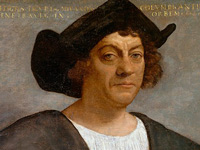
RESOURCES
This article uses material from the Wikipedia article "Christopher Columbus (1451-1506)", which is released under the Creative Commons Attribution-Share-Alike License 3.0.
© Stories Preschool. All Rights Reserved.
